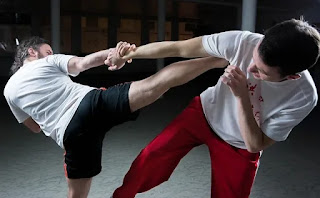Martial arts can be classified into two broad categories: combat martial arts and non-combat martial arts. While both types of martial arts can provide benefits in terms of physical fitness, mental discipline, and self-defence skills, there are some fundamental differences between the two.
Combat Martial Arts
Combat martial arts are designed to be used in real-life combat situations. These martial arts focus on training the practitioner to defend themselves and fight against an opponent. Techniques taught in combat martial arts include strikes, kicks, throws, joint locks, and chokes. Combat martial arts also emphasize physical fitness, strength, speed, and reflexes. Examples of combat martial arts include boxing, Muay Thai, Brazilian Jiu-Jitsu, Krav Maga, and judo.
Combat martial arts typically involve sparring or full-contact fighting to simulate real-life combat situations. This type of training can be physically and mentally demanding, as it requires the practitioner to react quickly and effectively to an opponent's attacks. Combat martial arts can also be more dangerous than non-combat martial arts, as the risk of injury is higher during sparring or full-contact fighting.
Non-Combat Martial Arts
Non-combat martial arts, on the other hand, are not designed for combat situations. These martial arts focus more on mental and spiritual development, self-discipline, and personal growth. Techniques taught in non-combat martial arts include forms, meditation, breathing exercises, and self-defence techniques. Examples of non-combat martial arts include tai chi, yoga, qigong, and aikido.
Non-combat martial arts typically do not involve sparring or full-contact fighting. Instead, practitioners of these martial arts focus on developing their mental and physical abilities through solo practice and partner work. Non-combat martial arts can be less physically demanding than combat martial arts, but they can still provide a challenging and rewarding workout.
Differences in Philosophy
The philosophy of combat martial arts and non-combat martial arts can also differ significantly. Combat martial arts tend to be more focused on self-defence and physical dominance, while non-combat martial arts emphasize harmony, balance, and inner peace.
Combat martial arts often have a competitive aspect to them, with tournaments and competitions designed to test the skills of the practitioners. Non-combat martial arts, on the other hand, tend to be more focused on personal development and self-improvement.
Choosing a Martial Art
When choosing a martial art to practice, it's important to consider your goals and preferences. If you're interested in learning self-defence skills and improving your physical fitness, combat martial art may be more suitable for you. If you're looking for a more meditative and introspective practice, a non-combat martial art may be a better fit.
It's also important to consider your physical abilities and any pre-existing injuries or conditions. Some combat martial arts can be quite physically demanding and may not be suitable for everyone. Non-combat martial arts can be a good option for those who are looking for a more gentle and low-impact practice.
In conclusion, while both combat and non-combat martial arts have their own unique benefits, they are fundamentally different in their approach, philosophy, and techniques. It's important to consider your goals and preferences when choosing a martial art to practice and to choose a style that is suitable for your physical abilities and limitations.
